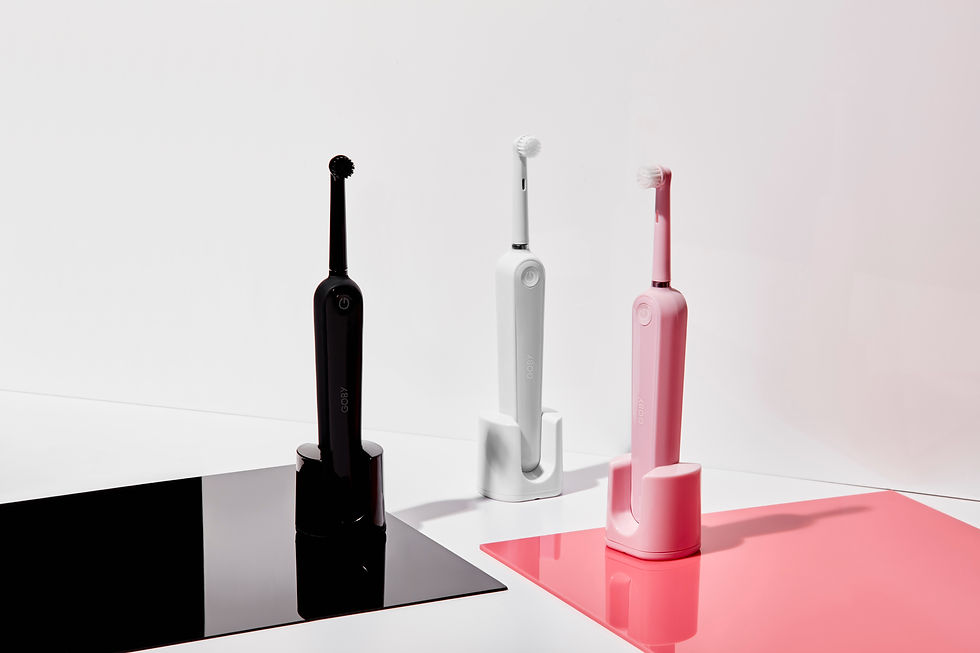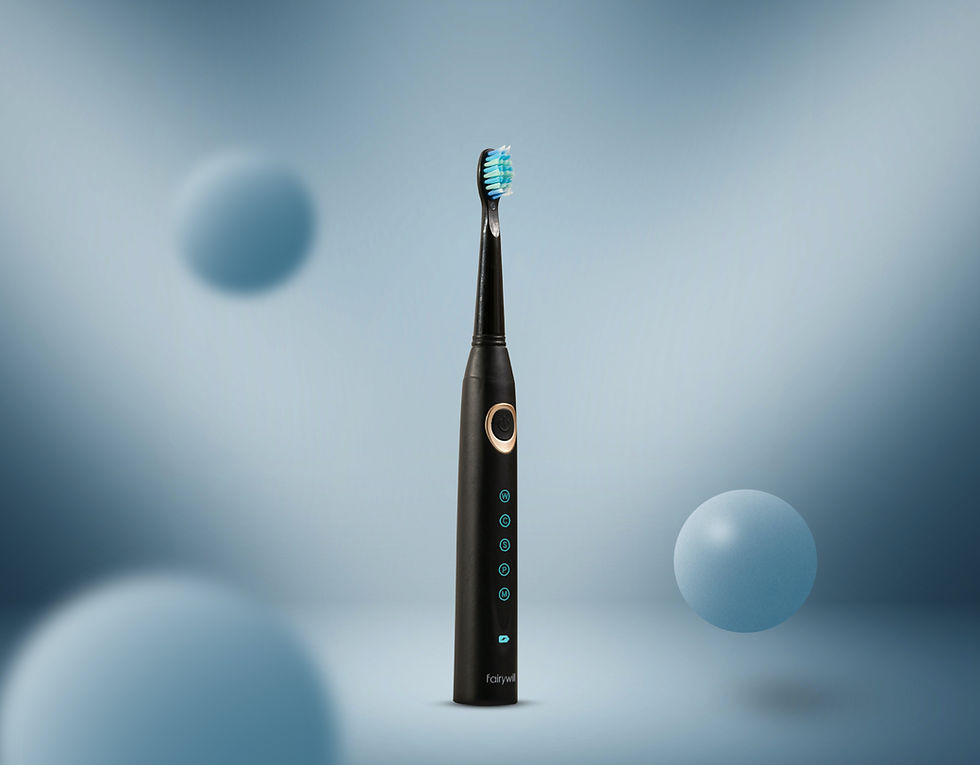The Best Electric Toothbrushes: A Comprehensive Guide.
- The Moolah Team
- Jul 1, 2023
- 8 min read
In this blog post, we will compare and review different electric toothbrushes, including their features, battery life, brush heads, and price, to help readers find the best toothbrush for their dental hygiene.
I. Introduction: The Importance of Choosing the Right Electric Toothbrush
Electric toothbrushes have revolutionized the way we approach oral hygiene, and for good reason. Studies have shown that electric toothbrushes can remove more plaque and improve gum health better than manual toothbrushes. But with so many different types of electric toothbrushes available, how do you choose the right one for your needs?
That's where this comprehensive guide comes in. We will explore the different features, battery life, brush heads, and price of electric toothbrushes to help you make an informed decision and achieve optimal oral health.
Choosing the right electric toothbrush can make all the difference in your dental hygiene routine. By utilizing the latest technology, electric toothbrushes can provide a more thorough clean than manual brushing alone. But with so many options available, it can be overwhelming to choose the right one.
The good news is that there are electric toothbrushes available for every budget and need. Whether you're looking for a basic model with a single brushing mode, or a high-end toothbrush with multiple modes and smart features, there is an electric toothbrush out there for you.
In the following sections, we will delve into the different features to consider when choosing an electric toothbrush, such as brushing modes, pressure sensors, timers, and smart features. We will also discuss battery life and charging time, brush head size and shape, bristle type, and replacement frequency. Finally, we will discuss price and provide recommendations for the best electric toothbrushes available at different price points.
In conclusion, choosing the right electric toothbrush is an important step in maintaining optimal oral health. By understanding the different features available and your personal needs and preferences, you can make an informed decision and enjoy a thorough, effective clean every time you brush.

II. Features to Consider When Choosing an Electric Toothbrush
When choosing an electric toothbrush, there are several features to consider to ensure that you get the most out of your investment. In this section, we will explore some of the most important features to look for when choosing an electric toothbrush.
A. Brushing Modes
Most electric toothbrushes come with multiple brushing modes, such as daily clean, sensitive, deep clean, and whitening. These modes vary in speed, intensity, and duration, allowing you to customize your brushing experience to your specific needs.
For example, if you have sensitive teeth or gums, a sensitive mode may be the best option for you, as it will provide a gentle, yet effective clean. If you are looking to whiten your teeth, a whitening mode may be more suitable, as it will help to remove surface stains.
B. Pressure Sensors
Some electric toothbrushes come with pressure sensors that alert you when you are brushing too hard. This is important, as brushing too hard can cause gum recession and tooth sensitivity. The pressure sensor will alert you with a light or sound when you are applying too much pressure, allowing you to adjust your brushing technique accordingly.
C. Timers
Most electric toothbrushes come with built-in timers that help you to brush for the recommended two minutes. Some toothbrushes also have quadrant timers, which signal you to move to a different area of your mouth every 30 seconds. This helps to ensure that you are brushing each quadrant of your mouth thoroughly and for the recommended amount of time.
D. Smart Features
Some electric toothbrushes come with smart features, such as Bluetooth connectivity and companion apps. These features can help you to track your brushing habits and identify areas where you may need to improve your technique.
For example, some companion apps provide real-time feedback on your brushing technique and suggest areas where you may need to brush more thoroughly. Some toothbrushes even come with AI technology that can track your brushing over time and provide personalized recommendations for improving your oral hygiene routine.
In conclusion, there are several features to consider when choosing an electric toothbrush, including brushing modes, pressure sensors, timers, and smart features. By understanding your personal needs and preferences, you can choose the best electric toothbrush for your oral hygiene routine.

III. Battery Life and Charging Options
When it comes to electric toothbrushes, battery life and charging options are important considerations. In this section, we will explore the different types of batteries used in electric toothbrushes and the various charging options available.
A. Battery Types
There are two main types of batteries used in electric toothbrushes: rechargeable and disposable. Rechargeable batteries are more common and allow you to recharge your toothbrush multiple times, making them more cost-effective in the long run. Disposable batteries, on the other hand, are not rechargeable and need to be replaced after a certain amount of use.
B. Battery Life
The battery life of an electric toothbrush can vary depending on the type of battery, brushing mode, and frequency of use. Most electric toothbrushes have a battery life of around two weeks to a month on a single charge. However, some high-end toothbrushes have longer battery life, lasting up to three months on a single charge.
C. Charging Options
Electric toothbrushes can be charged using different methods, including USB charging, induction charging, and plug-in charging. USB charging is convenient, as you can charge your toothbrush using a laptop or portable charger. Induction charging involves placing your toothbrush on a charging base, which uses electromagnetic waves to transfer power to the battery. Plug-in charging involves plugging your toothbrush into an electrical outlet.
Some toothbrushes also come with travel cases that double as charging stations, allowing you to charge your toothbrush on the go. This is especially useful for those who travel frequently or are always on the move.
D. Battery Replacement
For rechargeable electric toothbrushes, the battery will eventually need to be replaced after a certain amount of use. Most toothbrush manufacturers offer battery replacement services, but it is important to check if your toothbrush is still under warranty before replacing the battery.
In conclusion, battery life and charging options are important factors to consider when choosing an electric toothbrush. Understanding the different types of batteries, battery life, and charging options available will help you make an informed decision and ensure that your toothbrush lasts as long as possible.

IV. Brush Heads
The brush head is a crucial component of an electric toothbrush, as it is the part that actually comes into contact with your teeth and gums. In this section, we will explore the different types of brush heads available and their unique features.
A. Bristle Type
The bristle type is an important consideration when choosing a brush head. There are two main types of bristles: soft and hard. Soft bristles are recommended for those with sensitive teeth and gums, while hard bristles are better for those with tough, resilient gums.
B. Brush Head Size
The size of the brush head is also important, as it determines how effectively the toothbrush can clean hard-to-reach areas in the mouth. Most electric toothbrushes come with a standard-sized brush head, but some manufacturers offer different sizes and shapes to suit different needs.
C. Brush Head Shape
The shape of the brush head can also play a role in how well the toothbrush cleans your teeth. Some brush heads have a round shape, while others are angled or tapered. Round brush heads are ideal for general cleaning, while angled or tapered brush heads are better for reaching between teeth and cleaning around braces or other dental appliances.
D. Brush Head Replacement
It is important to replace your brush head regularly to ensure optimal cleaning and prevent the growth of bacteria. Most electric toothbrushes come with indicator bristles that fade over time to let you know when it is time to replace the brush head. As a general rule, brush heads should be replaced every three months or sooner if the bristles become frayed or damaged.
E. Specialty Brush Heads
Some electric toothbrushes come with specialty brush heads that are designed for specific dental needs, such as whitening, sensitive teeth, or gum care. These brush heads may have different bristle types, shapes, and sizes to target specific areas of the mouth and provide tailored cleaning.
In conclusion, choosing the right brush head is an important part of finding the best electric toothbrush for your dental hygiene needs. Consider factors such as bristle type, brush head size, shape, and replacement frequency, as well as any specialty brush heads that may be available for your toothbrush model. By selecting the right brush head, you can ensure that your electric toothbrush is effective in maintaining optimal oral hygiene.

V. Price
The price of an electric toothbrush is a significant factor to consider when making a purchase. While electric toothbrushes can be more expensive than traditional manual toothbrushes, they offer several advantages in terms of cleaning effectiveness and convenience. In this section, we will discuss the different price points of electric toothbrushes and what you can expect to get for your money.
A. Budget-Friendly Toothbrushes
Budget-friendly electric toothbrushes typically range from $20 to $50. These toothbrushes may not have all the bells and whistles of higher-end models, but they still offer a significant upgrade from manual toothbrushes. They may have fewer brush head options and may not come with a charging stand, but they still offer the benefits of powered brushing and improved cleaning effectiveness.
B. Mid-Range Toothbrushes
Mid-range electric toothbrushes typically range from $50 to $100. These toothbrushes often have more features than budget-friendly models, such as multiple brushing modes, longer battery life, and additional brush head options. They may also come with a charging stand and travel case for added convenience.
C. High-End Toothbrushes
High-end electric toothbrushes typically range from $100 to $250 or more. These toothbrushes offer the most advanced features, such as Bluetooth connectivity, pressure sensors, and real-time feedback on brushing technique. They may also come with a range of specialty brush heads for targeted cleaning and may have longer battery life than lower-priced models.
D. Replacement Brush Heads
It is important to consider the cost of replacement brush heads when purchasing an electric toothbrush. While some models may have a lower initial price, they may require more frequent replacement of brush heads, which can add up over time. It is important to factor in the cost of replacement brush heads when considering the overall value of an electric toothbrush.
In conclusion, the price of an electric toothbrush can vary widely depending on the features and quality of the model. Budget-friendly models offer a significant upgrade from manual toothbrushes, while mid-range models offer more features and convenience. High-end models offer the most advanced features and specialized cleaning options. When choosing an electric toothbrush, it is important to consider the features that are most important to you and your dental hygiene needs, as well as the cost of replacement brush heads over time.

VI. Conclusion
Choosing the best electric toothbrush for your dental hygiene needs can be a daunting task, but with the right information, you can make an informed decision. In this comprehensive guide, we have reviewed and compared different electric toothbrushes, including their features, battery life, brush heads, and price.
When choosing an electric toothbrush, it is important to consider your individual needs and preferences. Some people may prefer a toothbrush with a longer battery life, while others may prefer one with multiple brushing modes. The size and shape of the toothbrush handle, as well as the type and variety of brush heads, can also make a difference in the effectiveness and comfort of the brushing experience.
We have discussed the different types of electric toothbrushes available, including oscillating, sonic, and ultrasonic toothbrushes. Each type offers unique benefits and drawbacks, and the best choice for you may depend on your individual dental hygiene needs.
We also explored the various features that electric toothbrushes can offer, such as multiple brushing modes, pressure sensors, and Bluetooth connectivity. These features can enhance the effectiveness and convenience of the brushing experience, but may come at a higher price point.
Lastly, we discussed the price range of electric toothbrushes, from budget-friendly models to high-end options with advanced features. It is important to consider the overall value of the toothbrush, including the cost of replacement brush heads over time, when making a purchase decision.
In conclusion, an electric toothbrush can be a valuable investment in your dental hygiene routine. By choosing the right toothbrush for your needs and budget, you can improve the effectiveness and convenience of your brushing experience and maintain optimal oral health.
Thank you for taking the time to read our comprehensive guide to the best electric toothbrushes. We hope that the information provided has been helpful in guiding you towards the right toothbrush for your dental hygiene needs.
Remember, maintaining good oral health is an important part of overall wellness, and investing in an electric toothbrush can make a significant difference in the effectiveness and convenience of your brushing routine.
If you enjoyed this post and would like to stay up-to-date on the latest dental hygiene tips and product recommendations, be sure to subscribe to our newsletter.
Thank you for choosing Moolah, and here's to a brighter, healthier smile!
Moolah







Comments